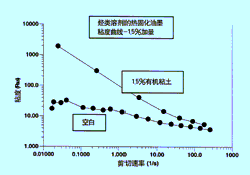Due to the thermal activation and operating requirements, reactive chemical gels cannot be added directly to the ink system, but are generally added during the production of the ink varnish. They serve to thicken by cross-linking the resin (Figure 9).
The thermal activation temperature of most systems is up to 300oF. Handling the reactive gels inappropriately may cause ink processing problems. For example, the gels and resins react too quickly and cause the system to produce small gel particles, or the product quality batch Problems such as inconsistencies between times. Typical applications for gel inks are radiation-cured, heat-cured, and UV-cured sites. Gel inks give the product excellent leveling and gloss effects.
The thermal activation temperature of most systems is up to 300oF. Handling the reactive gels inappropriately may cause ink processing problems. For example, the gels and resins react too quickly and cause the system to produce small gel particles, or the product quality batch Problems such as inconsistencies between times. Typical applications for gel inks are radiation-cured, heat-cured, and UV-cured sites. Gel inks give the product excellent leveling and gloss effects.

Today, a lot of work is being done to study new resin technologies, such as the development of "self-thickening" resins with good rheological properties to replace aluminum salt gels. However, gel inks and "self-thickening" resins still do not satisfy all the properties of the inks, such as their poor performance in fogging, emulsifying, and penetrating properties.
Most common physical type gels include organoclay and fumed silica. Both additives can be added directly to the ink system without the need for high temperature reaction conditions like the reactive gels.
Organic clay has been successfully used in ink systems for more than 50 years. It not only provides good ink viscosity, but also helps control ink fogging and ink penetration on porous media. The organoclay can be used either alone or in combination with a reactive adhesive to optimize the rheological properties of the ink (Figure 10).
In recent years, organic clays have been greatly improved in terms of dispersibility. Compared with old products, newly developed products have more open structures.
The open structure helps the organoclay to achieve better dispersion with less shear and less processing time, even without having to grind the ink. In general, these improvements can reduce production costs and increase production (Figures 11 and 12).
Organic thixotropic organic rheological agents as rheological additives can be added directly to the ink or added to the ink varnish. The main components of organic thixotropic agents are castor oil derivatives, amino functional polyesteramides and polyamides. Depending on the type of ink system and additives, organic thixotropic agents need to be added to the ink system in the range of 140 to 220oF. Under certain shear and temperature conditions, after some time (usually 15-20 minutes), the organic thixotropic particles disperse, soften, and swell.
Most common physical type gels include organoclay and fumed silica. Both additives can be added directly to the ink system without the need for high temperature reaction conditions like the reactive gels.
Organic clay has been successfully used in ink systems for more than 50 years. It not only provides good ink viscosity, but also helps control ink fogging and ink penetration on porous media. The organoclay can be used either alone or in combination with a reactive adhesive to optimize the rheological properties of the ink (Figure 10).
In recent years, organic clays have been greatly improved in terms of dispersibility. Compared with old products, newly developed products have more open structures.
The open structure helps the organoclay to achieve better dispersion with less shear and less processing time, even without having to grind the ink. In general, these improvements can reduce production costs and increase production (Figures 11 and 12).
Organic thixotropic organic rheological agents as rheological additives can be added directly to the ink or added to the ink varnish. The main components of organic thixotropic agents are castor oil derivatives, amino functional polyesteramides and polyamides. Depending on the type of ink system and additives, organic thixotropic agents need to be added to the ink system in the range of 140 to 220oF. Under certain shear and temperature conditions, after some time (usually 15-20 minutes), the organic thixotropic particles disperse, soften, and swell.


(To be continued)
Security Tape,Tamper Evident Security Void Tape,Security Label
Stretch Film Packing Tape Co., Ltd. , http://www.chstretchfilm.com